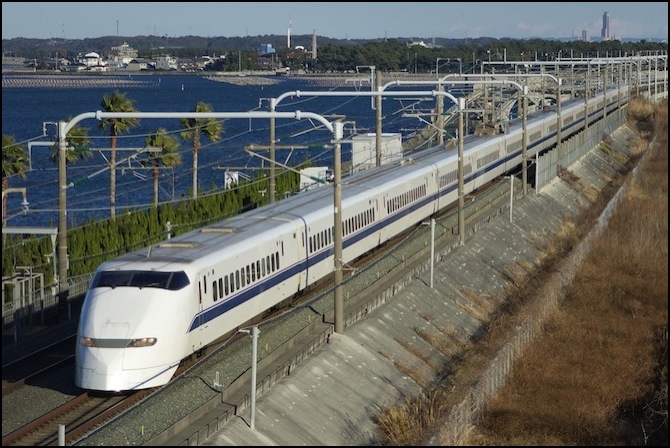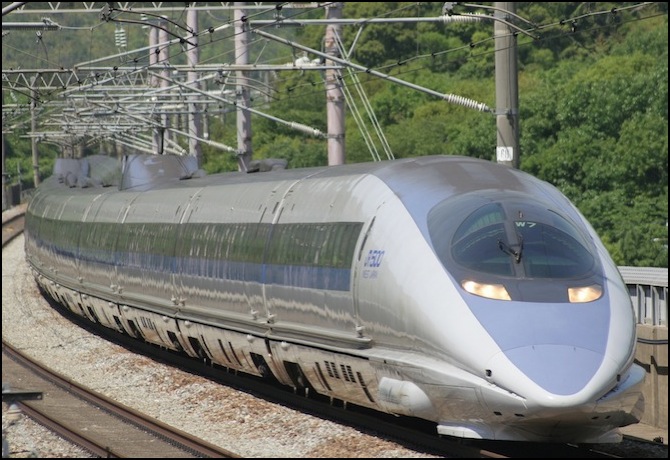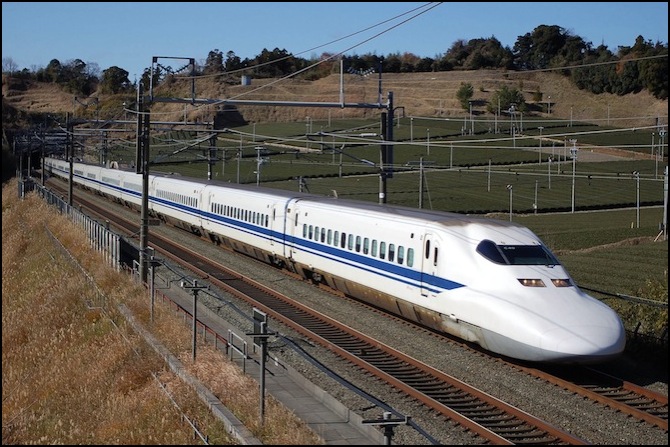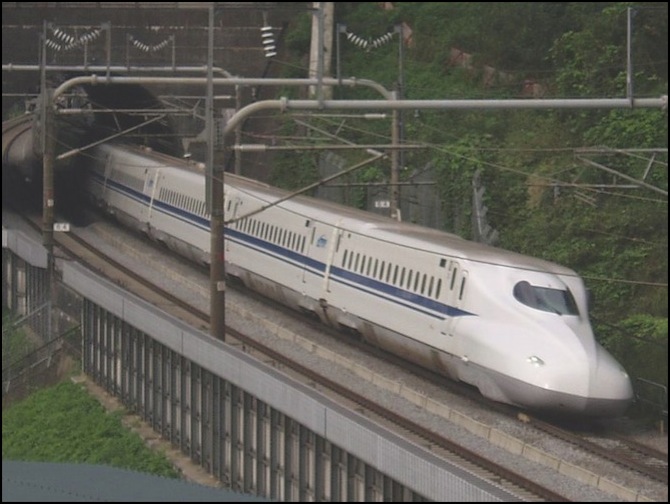Other Shinkansen in Tōkyō
The Tōkaidō Shinkansen to the west of Tōkyō is operated by JR Central. This line runs to Kyoto, 476 km from Tokyo, and Osaka, 515 km from Tōkyō. At Osaka it connects to the Sanyō Shinkansen. In Tōkyō, trains stop at both Shinagawa Station, in Minato ward, and at Tōkyō Station. Presently the 300 Series, 700 Series and N700 Series trains are used on this line. Formerly the 500 Series was used, but was withdrawn from service in early 2010. The 300 series is due to be withdrawn in 2012.
300 Series

JR Central 300 Series Shinkansen (2008)
Photographer: Sui-setz
Specifications:
Type: 300 Series
Size: 16-car trains
Introduced: 1992, to be retired in 2012
Lines: Tōkaidō and Sanyō
Top Speed: 270 kph
Power: 12,000 kW (16,092 hp), 40x 300 kW
Source: 25 kV AC, 60 Hz catenary
The long-serving 300 series is gradually being replaced by the new N700 series trains. The prototype 300 series train set the Shinkansen speed record of 325.7 kph in 1992, this was surpassed 18 months later by a design prototype, the 952/953, that was never produced as a production train. The 300 series was the last production-model Shinkansen to set a speed record (although the prototype was not quite identical to the production models, it was later updated to production standard and served until 2007).
500 Series

JR West 500 Series Shinkansen (2008)
Photographer: Mitsuki-2368
Specifications:
Type: 500 Series
Size: 16-car trains in original Tōkaidō line service, 8-car sets on present Sanyō line service
Introduced: 1997, retired from Tōkaidō line in 2010
Lines: Tōkaidō and Sanyō
Top Speed: 300 kph originally, 285 kph on Sanyō line today (design speed 320 kph)
Power: 18,240 kW (24,260 hp), 64x 285 kW (first set); 17,600 kW (23,602 hp), 64x 275 kW (later sets)
Source: 25 kV AC, 60 Hz catenary
The 500 series sets cost US$55 million each (5 billion yen), and were intended to be capable of 350 kph (217 mph) operation, although the final design was only capable of 320 kph (199 mph), and they were limited to 300 kph (186 mph) in actual service. Only nine sets were built. They are being replaced with newer trains with more aerodynamic nose shapes intended to reduce “tunnel boom”; shockwaves similar to sonic booms caused at tunnel exits by trains entering very narrow tunnels at high speed.
700 Series

JR Central 700 Series Shinkansen (2008)
Photographer: Sui-setz
Specifications:
Type: 700 Series
Size: 8- or 16-car trains
Introduced: 1999
Lines: Tōkaidō, Sanyō and Hakata-Minami Line
Top Speed: 270 kph (Tōkaidō), 285 kph (Sanyō)
Power: 13,200 kW (17,701 hp), 48x 275 kW for 16-cars, 6,600 kW (8,851 hp), 24x 275 kW for 8-cars
Source: 25 kV AC, 60 Hz catenary
The 700 series was developed as a lower cost (4 billion yen versus 5), lower power, and smoother-riding alternative to the 500 series, and 91 sets were produced. These displaced the 100 and 300 series when introduced. A minor variant 700-3000 series, with different bogie and pantograph detail, as well as a “JR 700” logo, is used on service to Tōkyō. The present JR West and JR Central Dr. Yellow diagnostic trains are based on the 700.
N700 Series

JR Central N700 Series Shinkansen (2007)
Photographer: Cassiopeia Sweet
Specifications:
Type: N700 Series
Size: 8- or 16-car trains
Introduced: 2007
Lines: Tōkaidō and Sanyō
Top Speed: 270 kph (Tōkaidō), 300 kph (Sanyō)
Power: 17,080 kW (22,905 hp), 56x 305 kW
Source: 25 kV AC, 60 Hz catenary
The N700 series is a tilt-train design, allowing it to maintain higher speeds through curves (270 kph on curves that formerly had a 255 kph limit). These trains are displacing 300 and 500 series trains, as well as downgrading 700 series trains to slower services (i.e., those with more stops). During a demonstration in 2009, the prototype 16-car Z0 N700 reached a speed of 332 kph.




